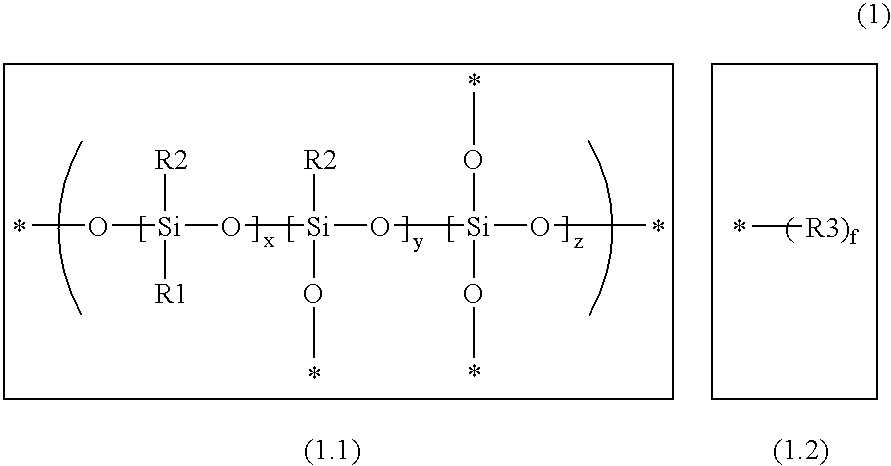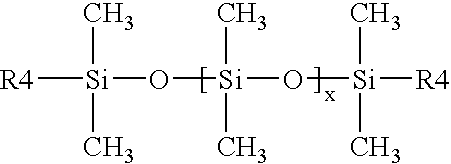Aziridinosilicones and the use thereof
a technology of aziridinosilicones and aziridinosilicones, which is applied in the field of aziridinosilicones, can solve the problems of low drawing sharpness, increased evolution of hydrogen, and impaired dimensional stability, and achieves high dimensional stability, good detail reproduction, and high impression accuracy.
- Summary
- Abstract
- Description
- Claims
- Application Information
AI Technical Summary
Benefits of technology
Problems solved by technology
Method used
Image
Examples
synthesis example 1
Preparation of an Aziridinosilicone from a Methacrylate-Terminated Silicone Oil
[0138]
[0139]100 g of DMS-R28 silicone oil (Gelest) [M=5000, 0.02 mol] are mixed with 50 ml of toluene and 3.44 g of aziridine (Ferak) [M=43.07, 0.08 mol]. The mixture is heated to 50° C., after five hours increased to 100° C. and held at 100° C. until a check of the conversion by IR spectroscopy indicates the disappearance of the C═C double bond. After conventional work-up and product isolation, 100 g of a clear, colorless aziridinosilicone remain.
synthesis example 2
Preparation of an Aziridinosilicone from an Acrylate-Terminated Silicone Oil
[0140]
[0141]100 g of DMS-U22 silicone oil (Gelest) [M=1100, 0.091 mol] are mixed with 50 ml of toluene. At 30° C., 31.3 g of aziridine [M 43.07, 0.73 mol] are added dropwise. The mixture is heated to 50° C., after five hours increased to 100° C. and held at 100° C. until a check of the conversion by IR spectroscopy indicates the disappearance of the C═C double bond. After conventional work-up and product isolation, 110 g of a clear, colorless aziridinosilicone remain.
synthesis example 3
Preparation of an Aziridinosilicone from a Silicone Oil Containing Pendant Acrylate Groups
[0142]
[0143]100 g of UMS-182 silicone oil (Gelest) [w=0.18*(v+w), 0.209 mol of acrylate groups] are mixed with 50 ml of toluene. At 30° C., 18.01 g of aziridine [M=43.07; 0.418 mol] are added dropwise. The mixture is heated to 50° C., after 5 hours increased to 100° C. and held at 100° C. until a check of the conversion by IR spectroscopy indicates the disappearance of the C═C double bond. After conventional work-up and product isolation, 105 g of a clear, colorless aziridino-silicone remain.
[0144]Examples of the preparation of dental materials are described below. With the aid of laboratory compounders, the catalyst components K1 to K3 described were prepared on a 100 g scale. The base components described in Table 1 were prepared on a 500 g scale.
[0145]Table 2 shows the mixtures investigated using the catalyst components described and the base component described in Table 1 in the weight rati...
PUM
| Property | Measurement | Unit |
|---|---|---|
| temperature | aaaaa | aaaaa |
| polydispersity | aaaaa | aaaaa |
| polydispersity | aaaaa | aaaaa |
Abstract
Description
Claims
Application Information
 Login to View More
Login to View More - R&D
- Intellectual Property
- Life Sciences
- Materials
- Tech Scout
- Unparalleled Data Quality
- Higher Quality Content
- 60% Fewer Hallucinations
Browse by: Latest US Patents, China's latest patents, Technical Efficacy Thesaurus, Application Domain, Technology Topic, Popular Technical Reports.
© 2025 PatSnap. All rights reserved.Legal|Privacy policy|Modern Slavery Act Transparency Statement|Sitemap|About US| Contact US: help@patsnap.com



